

Written by Brieanne Lyda-McDonald
Communities with high rates of incarceration experience damaged social networks and family ties, increased poverty and crime, and reduced life expectancy. These health implications are particularly relevant during the COVID-19 pandemic as they are risk factors for poor health outcomes if infected. To date, the North Carolina Department of Public Safety (NC DPS) is reporting that state prisons have recorded 34 positive COVID-19 tests (165 total tests). [Update: COVID-19 outbreaks are developing throughout the state prison system. Hundreds of inmates at the Neuse Correctional Institution in Goldsboro have tested positive for the virus. DPS closed the Johnston Correctional Institution in Smithfield on April 20 in order to send staff to the Neuse facility. Inmates from the Johnston facility have been transferred to other prisons.]
For the third edition in our “A Path Toward Health” series on the recently released Healthy North Carolina 2030 health indicators and goals, we’re highlighting the state’s incarceration rate and its connection to the ongoing COVID-19 pandemic. The HNC 2030 health goals reflect the broad range of factors that impact the health of North Carolinians, and the state’s priorities for improving health over the next decade. See the figure below for more information on the goal of decreasing incarceration.
Figure 1: HNC 2030 Health Goal: Reducing Incarceration in North Carolina

Incarceration has sweeping effects on communities, families, and individuals. High rates of incarceration weaken communities and contribute to adverse health outcomes. Application of law enforcement and sentencing has led to disproportionate incarceration rates, with African Americans making up 52% of the total incarcerated population, but only 22% of the population in North Carolina. In 2017, North Carolina’s incarceration rate was 203 per 100,000 whites, 488 per 100,000 American Indians, and 915 per 100,000 African Americans.

Many people enter prison with existing health conditions and don’t receive the proper medical attention while incarcerated. Inmates are likely to develop chronic conditions such as hypertension, diabetes, arthritis, and asthma. Incarcerated individuals also experience poor diets (high calorie, high fat, low nutrient density foods), low sanitation standards, and presence of infestations, among other poor conditions. There are currently around 35,000 people incarcerated in North Carolina state prisons, with about 23% of them being over the age of 50 and a third having at least one disability.
These health implications are particularly relevant during the COVID-19 pandemic. To date, NC DPS is reporting that state prisons have recorded 34 positive COVID-19 tests (165 total tests). There are no confirmed COVID-19 cases in state Juvenile Justice facilities. The Federal Bureau of Prisons is reporting that 46 inmates and 27 staff have tested positive for COVID-19 at the medium-security center, 14 inmates at the low-security center, and one inmate and one staff member at the medical center in Butner, NC. Four inmates from the medium-security center have died.
Given the health concerns and potential for serious outbreaks of the virus for groups living in confined spaces, NC DPS has implemented measures to decrease the spread of the virus. Over the past month, measures to decrease spread include suspending visitation and volunteering (beginning March 16) and the work release program (beginning March 25); implementing medical screenings for staff entering a prison; increasing health education for prisoners about COVID-19; doubling soap rations (beginning March 31); distributing cloth face masks (beginning April 6 and ongoing); and awarding time credits to allow some inmates to reduce their max sentence.
NC DPS is also considering the release of some incarcerated individuals to continue serving their sentence in community settings. To date, six inmates have been released and 500 others are being considered for early release. These measures are being targeted toward individuals who are at high risk for COVID-19:
The Juvenile Justice system is taking similar actions to reduce the number in detention and have reduced the daily detention population by 25% from the beginning of march to mid-April from 202 to 151.
Yet, there are many risk factors for the formerly incarcerated upon reentry into society such as limited resources, less educational attainment, disadvantages in employment, absence of drug rehabilitation resources, and unstable housing. This is a concern reflected in a response by NC DPS Secretary Erik Hooks to a lawsuit requesting the early release of inmates who are at high risk for complications from COVID-19. In his statement, Sec. Hooks said, “While reentry is complicated in the best of circumstances, the global pandemic caused by COVID-19 poses additional challenges… State housing is still limited and an offender who reenters the community without housing or other necessary support is particularly vulnerable to the challenges brought by COVID-19.”
Authors of a recent Health Affairs Blog post propose a “Roadmap for Emergency Discharge Planning During the COVID-19 Pandemic.” Their roadmap includes the following points to follow, when possible:
The COVID-19 pandemic is a complication to the health and safety of those incarcerated in North Carolina prisons. While reducing incarceration is a goal of HNC 2030, it will be vital to ensure that those being released at this time are able to access the resources they need to be healthy, safe, and successful in their reentry into society. As the state comes out of the pandemic in the long-term, the North Carolina Department of Health and Human Services will be working across sectors on ways to reduce the overall rate of incarcerations.
Read more in the A Path Toward Health series here: